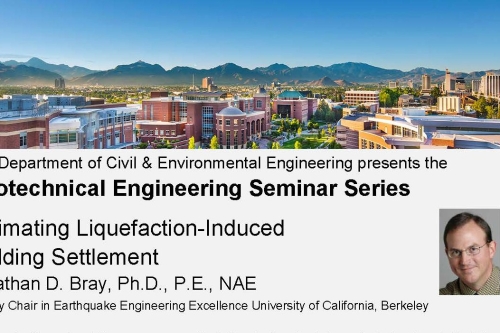Jonathan Bray, Faculty Chair in Earthquake Engineering Excellence, delivered the 1st Geotechnical Engineering Distinguished Seminar Series at the University of Nevada Reno on Nov. 22, 2019.
He spoke on "Estimating Liquefaction-Induced Building Settlement." (see flyer pdf)
Abstract
Significant settlement and damage may occur due to liquefaction of soils beneath shallow-founded buildings. The primary mechanisms of liquefaction-induced building settlement are shear-induced, volumetric-induced, and ejecta-induced ground deformation. Volumetric-induced free-field ground deformation may be estimated with available empirical procedures. Although challenging to estimate, ground failure indices and experience can be used to estimate roughly ejecta-induced building settlement. Nonlinear dynamic soil-structure interaction (SSI) effective stress analyses are required to estimate shear-induced ground deformation. Results from over 1,300 analyses identified earthquake, site, and building characteristics that largely control liquefaction-induced building settlement during strong shaking. A simplified procedure was developed based on the results of these analyses to estimate the shear-induced component of liquefaction building settlement. The standardized cumulative absolute velocity and 5%-damped spectral acceleration at 1 s period capture the ground shaking. The liquefaction building settlement (LBS) index, which is based on the shear strain potential of the site, captures in situ ground conditions. Building contact pressure and width capture the building characteristics. Field case histories and centrifuge test results validate the proposed simplified procedure. Recommendations and an example for evaluating building performance at liquefiable sites are shared.


